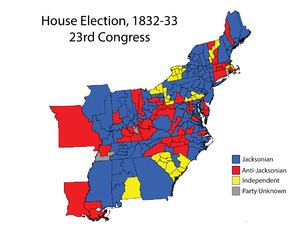July 2, 1832 - October 7, 1833 1834 → 143 63 17 seats 4 seats Start date 1832 | 126 seats 66 seats 17 3 25 9 | |
 | ||
Winner Andrew Stevenson | ||
Elections to the United States House of Representatives were held in 1832. They were held concurrently with the 1832 presidential election, in which Democrat Andrew Jackson was reelected.
Contents
The Jacksonians gained 17 seats, picking up several new seats in districts that were created following the 1830 Census; the rival National Republican Party lost a net total of three seats. Economic issues were key factors in this election. Southern agricultural districts reacted angrily to passage of the Tariff of 1832, which led to the Nullification Crisis. President Andrew Jackson and the Jacksonians showed a distrust for the banking sector, particularly the central Second Bank of the United States, which was strongly supported by the rival Anti-Jacksonian Party.
The third party Anti-Masonic Party, based on anti-Masonry, gained eight seats, and Nullifier Party, a John C. Calhoun-led state's rights party that supported South Carolina in the Nullification Crisis, picked up five seats, including all but one of the nine representatives in the South Carolina delegation.
Election summaries
Following the 1830 Census, 27 new seats were apportioned, with 4 States losing 1 seat each, 8 States having no change, and the remaining 12 States gaining between 1 and 6 seats.
Connecticut
Pennsylvania
Following the reapportionment resulting from the Fifth Census, Pennsylvania gained two representatives, increasing from 26 to 28, and was redistricted into 25 districts, two of which were plural districts
In the 1st district, Joel B. Sutherland (J) resigned sometime after the election to accept a judgeship, but then subsequently resigned that position and ran in the ensuing special election, winning the seat back.
